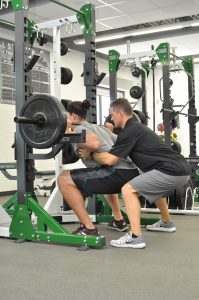 As High School Strength and Conditioning coaches we often deal with larger group sizes, with only a sport coach or two to assist implementing our programs.
As High School Strength and Conditioning coaches we often deal with larger group sizes, with only a sport coach or two to assist implementing our programs.
With this in mind, it is critical to put time into planning every aspect of your program to ensure that workouts flow efficiently and are effective at the same time.
Challenges with larger groups include lack of understanding from the athletes, lack of space, lack of equipment, athletes waiting for an exercise, and inability to coach every athlete individually.
Here are 4 strategies for addressing these Challenges:
Ensure Athletes have an understanding of each exercise and it’s goal
During the first weeks of training a large group, extensively cover each exercise and the purpose it has. When the athletes are informed of purpose and intent, it helps to maximize individual motivation.
It is also important to teach athletes the terminology and how to read/follow the workouts.
Make large groups, smaller
Plan to counteract lack of space/equipment with the planning of stations, where athletes will pair up in groups of 3-4.
Instead of having 60 kids perform the same movement within a space, you can have 3 groups of 20 with different exercises to create additional space.
This could include a group being in the hallway with Medicine balls, one group at the squat racks, and one group at the dumbbell rack.
Set a timer for each station to ensure athletes are staying on track.
Use Superset Exercises
A tactics to combat athletes standing around is the use of superset exercises. Often athletes are in our program 2-3 times a week, so we are completing full body workouts.
In the superset we will include an upper/lower exercise, a main compound lift with a mobility exercise, a push/pull movement, or contrast sets with a heavy lift with a high velocity jump.
Keep athletes moving with purpose through the station. There can be one athlete lifting, one athlete spotting, and another executing the other exercise.
Leverage “Partner-Coaching”
When there are numbers greater than 20 athletes it can be quite difficult to effectively coach up each athlete within the session.
To offset this, create athletes that partner coach the entire lift. This ties into point 1 where athletes need to be well informed on the lifts and their purpose.
If athletes pay attention to the cues that are used, they can repeat those same points to their partners to help coach them up.
Author: Lucas Mayo, MS, CSCS

Lucas Mayo is the Head Strength and Conditioning Coach at Brighton High School for Impact Sports Performance. Lucas is certified through the National Strength and Conditioning Association.
Lucas earned his Master’s degree in Sport Coaching and Leadership with a concentration in Strength and Conditioning.
Using methods based on research and experience, his mission is to aid in the positive mental and physical development of the athlete or individual over the course of their lifespan.


